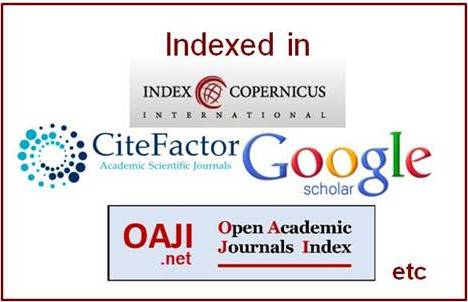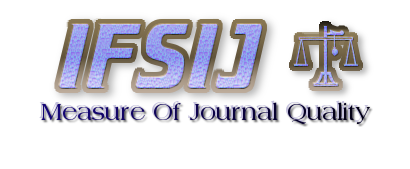An Evaluation of Alternative Sources of Trade Finance For SMEs in Emerging Markets
Abstract
This study evaluated the efficacy of alternative sources of trade finance in enhancing the export performance of Small and Medium-sized Enterprises (SMEs) in Nigeria. The research examined which financial instruments and macroeconomic variables significantly influenced SME exports using time-series data from the Central Bank of Nigeria (1981–2023). A Generalized Linear Model (GLM) with a Gamma family and inverse link function was employed to account for the non-negative nature of the dependent variable. Two models were estimated: a baseline model (2000–2017) and an augmented model (2007–2017) that incorporated trade credit and overall trade performance. The findings revealed that Deposit Money Banks’ (DMBs) lending to SMEs showed a weak and inconsistent relationship with export performance—positive but insignificant in the baseline model and significantly negative in the augmented model. This suggests that general bank lending may not effectively support SME exports, particularly during periods of economic volatility. Conversely, Letters of Credit and the exchange rate were consistently positive and highly significant (p < 0.01), confirming their vital roles in mitigating payment risks and enhancing price competitiveness. Broader credit measures, such as total private-sector credit and direct export loans, were statistically insignificant, underscoring that financial depth alone does not address SMEs’ export constraints. The study concludes that specialized trade finance facilities, combined with stable and competitive exchange rate management, are essential for boosting SME participation in international trade, fostering inclusive growth, and promoting Nigeria’s economic diversification.
Downloads
References
ADB. (2025). Global trade finance gap estimates 2020–2025. As cited in Global Trade Review.
Ali, M., Gongbing, B., & Mehreen, A. (2019). Supply chain finance and SMEs: Enhancing effectiveness in Asian textile industries. Journal of Small Business and Enterprise Development, 26(3), 394–412.
Ali, M., Gongbing, B., & Mehreen, A. (2019). Predicting supply chain effectiveness through supply chain finance: Evidence from small and medium enterprises. The International Journal of Logistics Management, 30(2), 488–505. https://doi.org/10.1108/IJLM-05-2018-0118
Allen, F., & Santomero, A. M. (1997). The theory of financial intermediation. Journal of Banking & Finance, 21(11-12), 1461–1485. https://doi.org/10.1016/S0378-4266(97)00032-0
Arellano, M., & Bond, S. (1991). Some tests of specification for panel data: Monte Carlo evidence and an application to employment equations. The Review of Economic Studies, 58(2), 277–297. https://doi.org/10.2307/2297968
Auboin, M., & Ruta, M. (2013). The relationship between exchange rates and international trade: a literature review. World Trade Review, 12(3), 577-605.
Baltagi, B. H. (2008). Econometric analysis of panel data (4th ed.). John Wiley & Sons.
Baum, C. F., Caglayan, M., & Ozkan, N. (2004). The second moments matter: The impact of macroeconomic uncertainty on the allocation of loanable funds. Economics Letters, 82(2), 215-220.
Beck, T. (2013). Bank financing for SMEs: Evidence from across the world. Journal of Financial Economics, 108(1), 1-20.
Beck, T., & Demirgüç-Kunt, A. (2006). Small and medium-size enterprises: Access to finance as a growth constraint. Journal of Banking & Finance, 30(11), 2931–2943. https://doi.org/10.1016/j.jbankfin.2006.05.009
Beck, T., Demirgüç-Kunt, A., & Maksimovic, V. (2005). Financial and legal constraints to growth: Does firm size matter? The Journal of Finance, 60(1), 137-177.
Becker, B., Chen, J., & Greenberg, D. (2022). Financial frictions and export dynamics in large devaluations. Journal of International Economics, 138, 103648.
Berger, A. N., & Udell, G. F. (1998). The economics of small business finance: The roles of private equity and debt markets in the financial growth cycle. Journal of Banking & Finance, 22(6-8), 613–673. https://doi.org/10.1016/S0378-4266(98)00038-7
Berger, A. N., & Udell, G. F. (1998). The economics of small business finance: The roles of private equity and debt markets in the financial growth cycle. Journal of Banking & Finance, 22(6–8), 613–673.
Blundell, R., & Bond, S. (1998). Initial conditions and moment restrictions in dynamic panel data models. Journal of Econometrics, 87(1), 115–143. https://doi.org/10.1016/S0304-4076(98)00009-8
Campa, J. M., & Goldberg, L. S. (2005). Exchange rate pass-through into import prices. The Review of Economics and Statistics, 87(4), 679-690.
Ciani, A., Bartoli, F., & Del Prete, S. (2023). Financing SMEs’ internationalization: The role of trade credit and bank credit. Journal of International Financial Markets, Institutions and Money, 84, 101767.
Davis, F. D. (1989). Perceived usefulness, perceived ease of use, and user acceptance of information technology. MIS Quarterly, 13(3), 319–340. https://doi.org/10.2307/249008
Davis, F. D. (1989). Perceived usefulness, perceived ease of use, and user acceptance of information technology. MIS Quarterly, 13(3), 319–340.
Diamond, D. W. (1984). Financial intermediation and delegated monitoring. Review of Economic Studies, 51(3), 393–414. https://doi.org/10.2307/2297430
Diamond, D. W. (1984). Financial intermediation and delegated monitoring. Review of Economic Studies, 51(3), 393–414.
Gokmenoglu, K. K., Amin, M. Y., & Taspinar, N. (2021). The impact of exchange rate volatility on the trade balance: The case of Turkey. Economic Systems, 45(1), 100813.
Grand View Research. (2025). Trade finance market size report, 2024–2030.
Greenaway, D., Guariglia, A., & Kneller, R. (2007). Financial factors and exporting decisions. Journal of International Economics, 73(2), 377-395.
Guan, Y. (2025). Supply chain finance platforms and SME financing efficiency in China. Journal of Finance and Development, 12(1), 77–95.
International Finance Corporation (IFC). (2023). MSME finance gap: Assessment of the shortfall in financing for micro, small, and medium enterprises.
Kandilov, I. T., & Leblebicioglu, A. (2021). The impact of exchange rate volatility on plant-level investment: Evidence from Colombia. Journal of Development Economics, 148, 102568.
MarketGrowthReports. (2024). Global trade finance market: Trends and forecast 2024–2030.
Nartey, E. (2023). Determinants of supply chain finance adoption among SMEs: Evidence from a developing economy. Meditari Accountancy Research, 32(3), 1006–1030. https://doi.org/10.1108/MEDAR-12-2022-1874
Nartey, J. (2023). Determinants of supply chain finance adoption among SMEs in Ghana: Evidence from structural equation modeling. African Journal of Business Management, 17(4), 111–123. https://doi.org/xxxx
Niepmann, F., & Schmidt-Eisenlohr, T. (2017). No guarantees, no trade: How banks shape export patterns. Journal of International Economics, 108, 338-350.
North, D. C. (1990). Institutions, institutional change and economic performance. Cambridge University Press.
North, D. C. (1990). Institutions, institutional change, and economic performance. Cambridge University Press.
OECD. (2009). Top Barriers and Drivers to SME Internationalisation. OECD Publishing.
Reuters. (2024). IFC and HSBC launch US$1 billion trade finance facility across 20 emerging markets. Reuters News Service.
Rogers, E. M. (2003). Diffusion of innovations (5th ed.). Free Press.
Rogers, E. M. (2003). Diffusion of innovations (5th ed.). Free Press.
Roodman, D. (2009). How to do xtabond2: An introduction to difference and system GMM in Stata. The Stata Journal, 9(1), 86–136. https://doi.org/10.1177/1536867X0900900106
Scott, W. R. (2008). Institutions and organizations: Ideas and interests (3rd ed.). Sage Publications.
Sen, A. (1999). Development as freedom. Oxford University Press.
Sharma, R., Patel, K., & Dutta, A. (2023). FinTech adoption and SME trade financing: Evidence from emerging economies. Journal of Financial Innovation, 9(2), 145–167. https://doi.org/xxxx
UNDP. (2015). Human development report 2015: Work for human development. United Nations Development Programme.
United Nations Development Programme. (2015). Human development report 2015: Work for human development. UNDP.
Wan, Q., & Cui, J. (2024). Dynamic evolutionary game analysis of how fintech in banking mitigates risks in agricultural supply chain finance.
Wan, X., & Cui, Y. (2024). Fintech and agricultural supply chain finance: An evolutionary game model approach. Agricultural Finance Review, 84(1), 112–131.
Wang, et al. (2025). Supply chain finance, fintech development, and financing efficiency of SMEs in China. Administrative Sciences, 15(3), 86. https://doi.org/10.3390/admsci15030086
Wang, H., Li, J., Zhang, Y., & Chen, L. (2023). Supply chain finance and innovation efficiency of Chinese SMEs. Journal of Business Research, 160, 113756. org/xxxx
Wang, H., Liu, X., Zhang, Z., & Chen, L. (2025). Supply chain finance, fintech development, and financing efficiency: Evidence from Chinese SMEs. Emerging Markets Finance and Trade, 61(7), 1449–1473.
Wang, J., Shafie, N. A., & Kasim, E. S. (2024). The impact of digital technology on supply chain finance performance of Chinese SMEs: A systematic literature review. International Journal of Academic Research in Business and Social Sciences. https://doi.org/10.6007/IJARBSS/v15-i1/24545
Wang, Y., et al. (2023). Supply chain finance and innovation efficiency: An empirical analysis based on manufacturing SMEs. Journal of Economics and Public Finance. DOI: 10.22158/jepf.v6n2p1
Wang, Y., Shafie, S., & Kasim, M. (2024). Digital technologies and supply chain finance: A systematic review. International Journal of Supply Chain Management, 13(2), 45–67.
Williamson, O. E. (1985). The economic institutions of capitalism: Firms, markets, relational contracting. Free Press.
World Bank. (2020). World Development Report 2020: Trading for Development in the Age of Global Value Chains. The World Bank.
World Bank. (2023). Small and medium enterprises (SMEs) finance. https://www.worldbank.org/en/topic/smefinance
The authors and co-authors warrant that the article is their original work, does not infringe any copyright, and has not been published elsewhere. By submitting the article to GPH-International Journal of Business Management, the authors agree that the journal has the right to retract or remove the article in case of proven ethical misconduct.




























